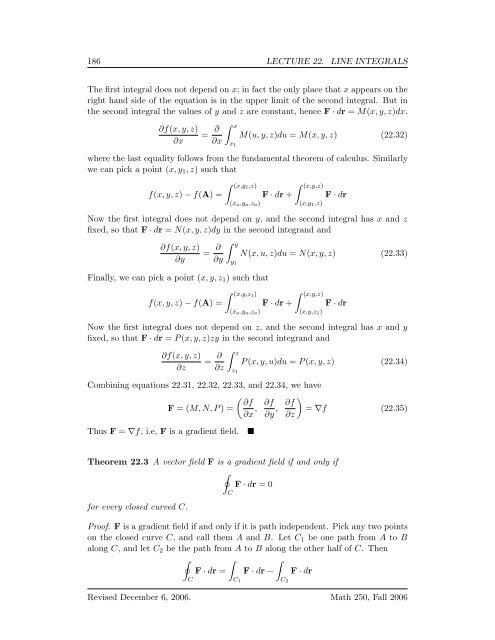Multivariate Calculus - Bruce E. Shapiro
Multivariate Calculus - Bruce E. Shapiro
Multivariate Calculus - Bruce E. Shapiro
You also want an ePaper? Increase the reach of your titles
YUMPU automatically turns print PDFs into web optimized ePapers that Google loves.
186 LECTURE 22. LINE INTEGRALS<br />
The first integral does not depend on x; in fact the only place that x appears on the<br />
right hand side of the equation is in the upper limit of the second integral. But in<br />
the second integral the values of y and z are constant, hence F · dr = M(x, y, z)dx.<br />
∂f(x, y, z)<br />
∂x<br />
= ∂<br />
∂x<br />
∫ x<br />
x 1<br />
M(u, y, z)du = M(x, y, z) (22.32)<br />
where the last equality follows from the fundamental theorem of calculus. Similarly<br />
we can pick a point (x, y 1 , z) such that<br />
f(x, y, z) − f(A) =<br />
∫ (x,y1 ,z)<br />
(x a,y a,z a)<br />
F · dr +<br />
∫ (x,y,z)<br />
(x,y 1 ,z)<br />
F · dr<br />
Now the first integral does not depend on y, and the second integral has x and z<br />
fixed, so that F · dr = N(x, y, z)dy in the second integrand and<br />
∂f(x, y, z)<br />
∂y<br />
= ∂ ∂y<br />
∫ y<br />
y 1<br />
N(x, u, z)du = N(x, y, z) (22.33)<br />
Finally, we can pick a point (x, y, z 1 ) such that<br />
f(x, y, z) − f(A) =<br />
∫ (x,y,z1 )<br />
(x a,y a,z a)<br />
F · dr +<br />
∫ (x,y,z)<br />
(x,y,z 1 )<br />
F · dr<br />
Now the first integral does not depend on z, and the second integral has x and y<br />
fixed, so that F · dr = P (x, y, z)zy in the second integrand and<br />
∂f(x, y, z)<br />
∂z<br />
= ∂ ∂z<br />
∫ z<br />
z 1<br />
P (x, y, u)du = P (x, y, z) (22.34)<br />
Combining equations 22.31, 22.32, 22.33, and 22.34, we have<br />
( )<br />
∂f<br />
F = (M, N, P ) =<br />
∂x , ∂f<br />
∂y , ∂f<br />
= ∇f (22.35)<br />
∂z<br />
Thus F = ∇f, i.e, F is a gradient field.<br />
<br />
Theorem 22.3 A vector field F is a gradient field if and only if<br />
∮<br />
F · dr = 0<br />
for every closed curved C.<br />
C<br />
Proof. F is a gradient field if and only if it is path independent. Pick any two points<br />
on the closed curve C, and call them A and B. Let C 1 be one path from A to B<br />
along C, and let C 2 be the path from A to B along the other half of C. Then<br />
∮<br />
F · dr =<br />
C<br />
∫<br />
F · dr −<br />
C 1<br />
∫<br />
F · dr<br />
C 2<br />
Revised December 6, 2006. Math 250, Fall 2006
















